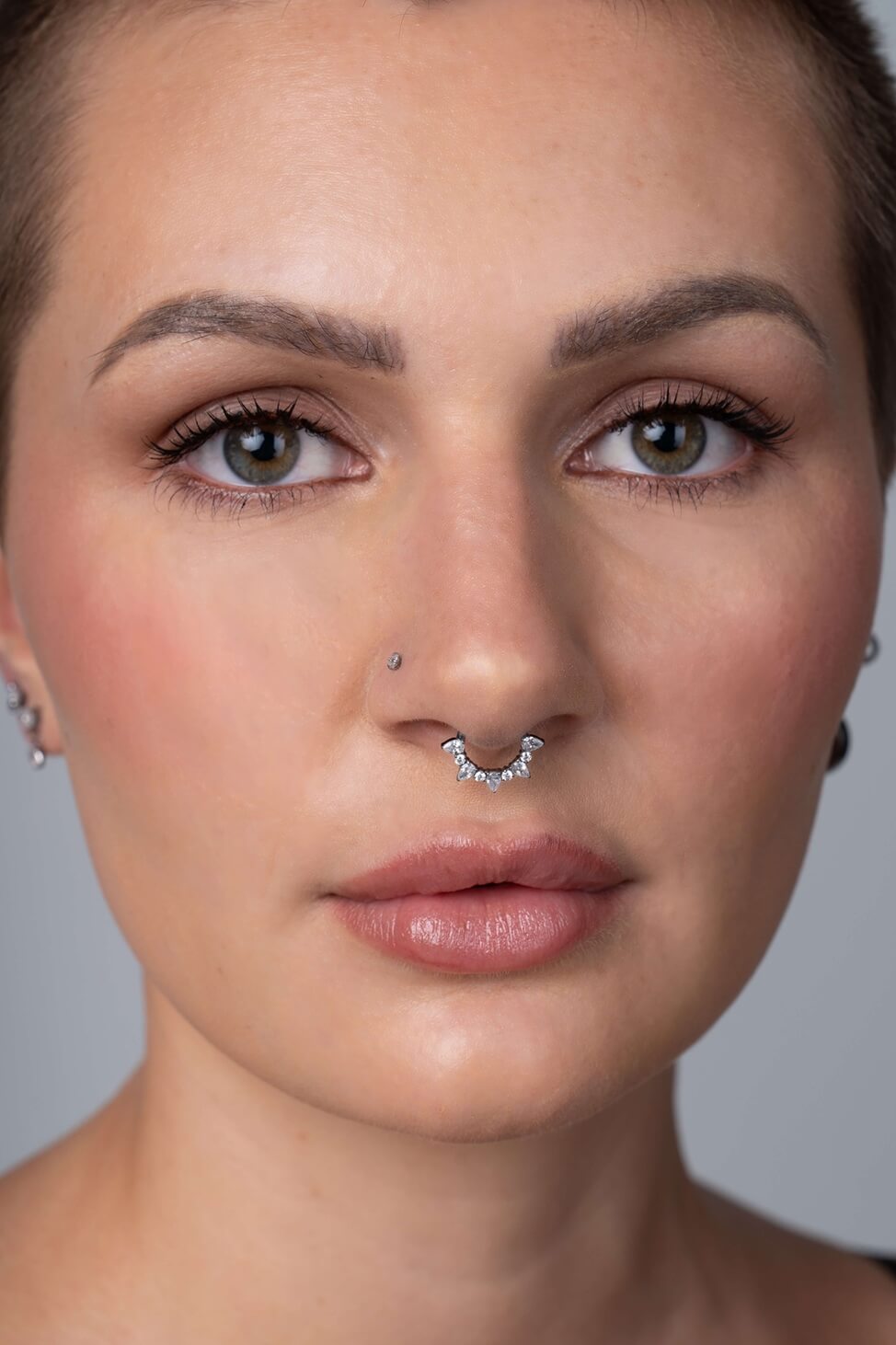Your Post-Piercing Aftercare Guide
Getting pierced is just the beginning, how you look after your new piercing makes all the difference. Proper aftercare helps your piercing heal smoothly, look amazing, and stay problem-free for years to come.
At SkinKandy, our piercing pros will walk you through everything in-store, but this guide is here as a refresher. Everybody is different, so think of this as general advice, your piercer may give you extra tips based on your anatomy and jewellery.
If you notice anything unusual, or you’ve reacted to piercings in the past, come and see us in-store. We’re always here to help, and it’s much better to check in than to worry.

EAR PIERCING AFTERCARE

ear
Lobe Piercings
Never touch a fresh or healing piercing, including sleeping on or causing any sort of movement or pressure (and picking off crusties!). Clean twice a day with aftercare solution and do not remove the jewellery. Avoid soaking in any bodies of water (including ocean and pool) and rinse thoroughly after washing in the shower. Check the backings regularly to ensure it hasn't clipped on too tightly, causing a build-up of pressure. Change pillowcases regularly. Swelling can be expected. Healing time can take up to 3-6 months, but can usually be changed to slightly shorter, sterile jewellery from 6-8 weeks. Please visit your local store for an in-house check-up with one of our expert piercers.

Ear
Cartilage Piercings
Never touch a fresh or healing piercing, including sleeping on or causing any sort of movement or pressure (and picking off crusties!). Clean twice a day with aftercare solution and do not remove the jewellery. Avoid soaking in any bodies of water (including ocean and pool) and rinse thoroughly after washing in the shower. Change pillowcases regularly. For piercings in tight spaces (such as rooks, forward helix), we recommend the use of a handheld electric fan to dry the area thoroughly. Excess moisture promotes bacterial growth and creates an environment that hinders healing. Avoid ear plugs for the duration of healing where they might interfere with the piercing (eg. tragus and daith). Swelling (and sometimes bleeding or bruising) can be expected. Healing time can take up to 6-12 months, but can usually be changed to slightly shorter, sterile jewellery from 6-8weeks, piercings such as daith and industrial can take a little bit longer to be ready for a downsize so we recommend doing so at 8-10 weeks for this particular piercings. Please visit your local store for an in-house check up with one of our expert piercers.
Healed Piercing? Shop Ears Fashion Jewellery.
NOSE PIERCING AFTERCARE

Nose
Nostril Piercings
Never touch a fresh or healing piercing, including sleeping on or causing any sort of movement or pressure (and picking off crusties!). Clean twice a day with aftercare solution and do not remove the jewellery. Avoid soaking in any bodies of water (including ocean and pool) and rinse thoroughly after washing in the shower. Change pillowcases regularly. Avoid placing foreign chemicals or objects inside the pierced nostril, as some medicated nasal sprays can disrupt the healing process. Avoid makeup, cleanser and moisturiser in the area and be careful of things such as glasses and caps for the duration of healing. For a nostril piercing with a stud, consider a band-aid at night for extra support to avoid getting it caught. Swelling can be expected. Healing time can take up to 6-12 months, but can usually be changed to slightly shorter, sterile jewellery from 6-8 weeks. Please visit your local store for an in-house check-up with one of our expert piercers.

Nose
Septum Piercings
Never touch a fresh or healing piercing, including sleeping on or causing any sort of movement or pressure (and picking off crusties!). Clean twice a day with aftercare solution and do not remove the jewellery. Avoid soaking in any bodies of water (including ocean and pool) and rinse thoroughly after washing in the shower. Change pillowcases regularly. Avoid makeup around the area. Avoid placing foreign chemicals or objects inside the pierced nostril, as some medicated nasal sprays can disrupt the healing process. If required to have it tucked/hidden, it is recommended to keep it that way for the duration of healing. Swelling (and sometimes bleeding) can be expected. Healing time can take up to 6-12 months, but can usually be changed to slightly shorter, sterile jewellery from 6-8 weeks. Please visit your local store for an in-house check-up with one of our expert piercers.
Healed Piercing? Shop Nose Fashion Jewellery
FACE & MOUTH PIERCING AFTERCARE

Mouth
Lip Piercings
Never touch a fresh or healing piercing, including sleeping on or causing any sort of movement or presser (and picking off crusties!). Clean twice a day with oral-safe aftercare solution and do not remove the jewellery. Avoid soaking in any bodies of water (including ocean and pool) and rinse thoroughly after washing in the shower. Change pillowcases regularly. Avoid makeup, cleanser and moisturiser in the area for the duration of healing and avoid consuming dairy, excessive sugar, spicy food, alcohol and cigarettes for the first 2 weeks. Swelling (and sometimes bleeding or bruising) can be expected. Healing time can take up to 4-6 months. Please visit your local store for an in-house check-up with one of our expert piercers.

mouth
Other Oral Piercings
Tongue • Smiley • Tongue Webbing
Never touch a fresh or healing piercing, including sleeping on it or causing any movement or pressure (and picking off crusties!). Clean twice a day with an oral-safe aftercare solution, using sterile saline only, and do not remove the jewellery. After spraying, rinse your mouth with clean water and spit it out into a sink. Get a new toothbrush to reduce bacteria exposure. Stick to your usual dental hygiene routine, but avoid excessive cleaning, as it can increase the risk of oral thrush. If you use mouthwash, make sure it’s alcohol-free. Avoid consuming dairy, excessive sugar, spicy food, alcohol, and cigarettes for the first 2 weeks. Keep makeup, cleansers, and moisturisers away from the piercing. Avoid swimming or soaking in water, and rinse thoroughly after showers. Downsize your initial piercing jewellery as recommended by your piercer to prevent dental damage. Healing typically takes 4–6 months, but jewellery changes can be made after 6–8 weeks if necessary. For the best healing results, please visit your local store for an in-house check-up with one of our expert piercers.

face
Eyebrow Piercings
Never touch a fresh or healing piercing, including sleeping on or causing any sort of movement or pressure (and picking off crusties!). Clean twice a day with aftercare solution and do not remove the jewellery. Avoid soaking in any bodies of water (including ocean and pool) and rinse thoroughly after washing in the shower. Change pillowcases regularly. Avoid makeup, cleanser and moisturiser in the area and be careful of things such as glasses and caps for the duration of healing. Swelling (and sometimes bleeding or bruising) can be expected. Healing time can take up to 6 months, but can usually be changed to slightly shorter, sterile jewellery from 6-8 weeks. Please visit your local store for an in-house check-up with one of our expert piercers.

Face
Bridge Piercings
Never touch a fresh or healing piercing, including sleeping on or causing any sort of movement or pressure (and picking off crusties!). Clean twice a day with aftercare solution and do not remove the jewellery. Avoid soaking in any bodies of water (including ocean and pool) and rinse thoroughly after washing in the shower. Change pillowcases regularly. Avoid makeup, cleanser and moisturiser in the area and be careful of things such as glasses and caps for the duration of healing. Swelling (and sometimes bleeding or bruising) can be expected. Healing time can take up to 6-12 months, but can usually be changed to slightly shorter, sterile jewellery from 6-8 weeks. Please visit your local store for an in-house check-up with one of our expert piercers.
BODY PIERCING AFTERCARE

body
Navel Piercings
Never touch a fresh or healing piercing, including sleeping on or causing any sort of movement or pressure (and picking off crusties!). Clean twice a day with aftercare solution and do not remove the jewellery. Avoid soaking in any bodies of water (including ocean and pool) and rinse thoroughly after washing in the shower. For piercings in tight spaces such as navel, we recommend the use of a handheld electric fan to dry the area thoroughly. Excess moisture promotes bacterial growth and creates an environment that hinders healing. Avoid tight clothing for the duration of healing. Swelling (and sometimes bleeding or bruising) can be expected. Healing time can take up to 6-12 months, but can usually be changed to slightly shorter, sterile jewellery from 6-8 weeks. Please visit your local store for an in-house check-up with one of our expert piercers.
Healed Piercing? Shop Navel Fashion Jewellery

body
Nipple Piercings
Never touch a fresh or healing piercing, including sleeping on or causing any sort of movement or pressure (and picking off crusties!). Clean twice a day with aftercare solution and do not remove the jewellery. Avoid soaking in any bodies of water (including ocean and pool) and rinse thoroughly after washing in the shower. Swelling (and sometimes bleeding or bruising) can be expected. Healing time can take up to 6-12 months, but can usually be changed to slightly shorter, sterile jewellery from 8-10 weeks. Please visit your local store for an in-house check-up with one of our expert piercers.
Healed Piercing? Shop Nipple Fashion Jewellery

body
Surface Piercings
Never touch a fresh or healing piercing, including sleeping on or causing any sort of movement or pressure (and picking on crusties!). Clean twice a day with aftercare solution and do not remove the jewellery. Avoid soaking in any bodies of water (including ocean and pool) and rinse thoroughly after washing in the shower. Swelling (and sometimes bleeding or bruising) can be expected. Healing time can take up to 6-12 months, but tops can usually be changed to sterile jewellery from 6-8 weeks. Please visit your local store for an in-house check-up with one of our expert piercers.

body
Dermal Piercings
Your new dermal piercing should be kept covered for at minimum 4-6 weeks using a bandaid, this will ensure the area is secure from knocks and will protect it from bacteria during its initial healing phase. Clean twice per day with sterile saline solution. Remove the bandaid carefully before cleaning to ensure it isn’t stuck to the jewellery, and replace with a new, clean Band-Aid after you have completed your aftercare routine. Healing time can take up to 6-12 months, but tops can usually be changed to sterile jewellery from 12 weeks. Please visit your local store for an in-house check-up with one of our expert piercers. Swelling (and sometimes bleeding and bruising) can be expected.
Please note: Dermal removal must be performed by a GP or licensed medical professional.
A few things to remember.
Every piercing heals at its own pace, don’t compare yours to someone else’s. Never touch or twist your jewellery, clean with sterile saline only. Avoid pools, beaches, and baths until your piercer says it’s safe. Change to shorter jewellery only when recommended by your piercer (Read about Downsizing).
We’re with you all the way.
Every SkinKandy piercing comes with our Piercing Guarantee, safe procedure, expert aftercare, and free downsizing with SkinKandy jewellery purchase.
Need reassurance? Visit any of our stores for a free check-up. Our pros are always happy to answer questions.

















